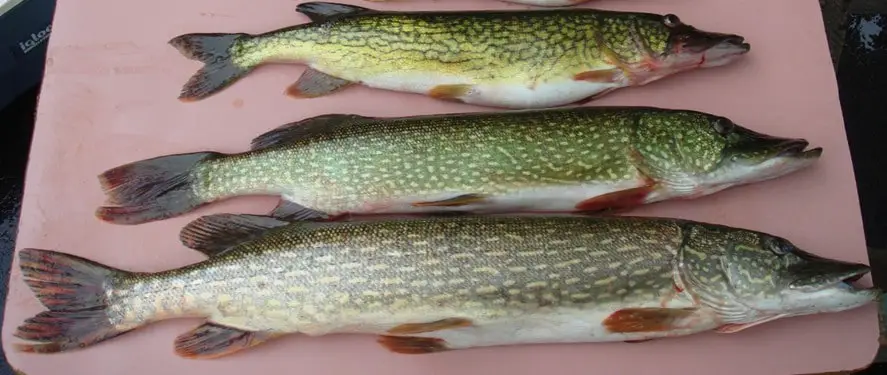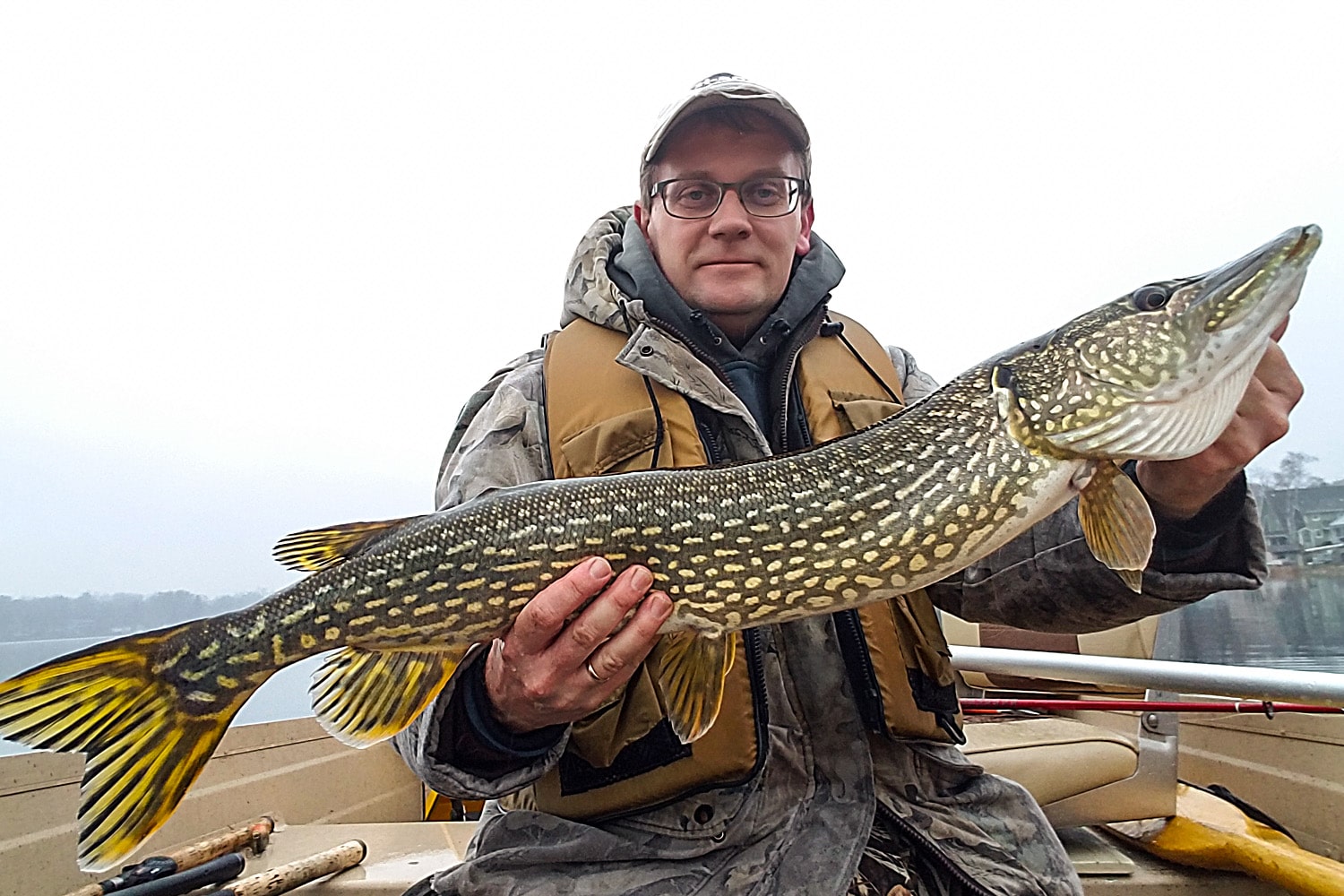Most anglers believe that pickerels are the same as these small pikes lurk in the same waters. And not to mention, they look incredibly similar! But what many don’t know is that these two are separate species. So, what’s the difference between Chain Pickerel vs Northern Pike?
Generally, the Nothern Pike is larger than the average Chain Pickerel. But there are many ways to distinguish the difference between both fish.
To make it easy for you, I wrote this informative species guide on the topic of Pike vs. Pickerel. Read on to accurately tell these two apart like a pro—in no time!
How to Tell Chain Pickerel vs Northern Pike Apart

Although the Northern Pike and Chain Pickerel are different species, they’re very similar. These two fish belong to the broader pike family Escocidae and genus Esox. That’s why it can be difficult to tell these two fish apart, especially if you have no prior knowledge.
But familiarizing yourself with the factors below can help you identify the two fish like a pro in no time:
Weight and Length
The weight and length of fish are some of the most convenient ways to tell them apart. And this also applies to the Chain Pickerel and Northern Pike. Generally, the Northern Pike becomes large than most Chain Pickerels.
Compared to the strong apex predator, the Northern Pike, the Chain Pickerel is small. Pikes can grow up to a max of 50 inches. On the other hand, Pickerels can grow to a maximum length of 25 inches.
Moreover, Northern Pikes are heavier than Chain Pickerels as they weigh an average of 5 to 10 lbs. And these apex predators can grow over 40 lbs! Meanwhile, the Chain Pickerel can grow anywhere between 2 to 4 lbs with a max-weight of 9 lbs.
Overall, if it’s bigger, longer, and meaner, it’s probably a Northern Pike. Otherwise, you’re facing a smaller and calmer Chain Pickerel.
Gill Plates
Finally, the gill plate is the hardest difference to find between a Pike and Pickerel. Even the most experienced anglers don’t often spot this factor. After all, you’ll need to have a close look to see the gill plates.
However, the Northern Pike’s gill plates lack any scales in general. On the other hand, a Chain Pickerel has a gill plate covered in scales. So once you find a quick and easy way to see the gill plate, you’ll be a pro in no time.
Fins
One of the easiest ways to distinguish Chain Pickerels from Northern Pikes is via their fins. After all, the Northern Pike has more reddish or brownish fins, while the Pickerel has paler fins. Plus, the Chain Pickerel usually has faded orange or brown fins.
Aside from the colors, the fins’ size is crucial as well. For Northern Pikes, expect rounder and bigger fins. On the other hand, Chain Pickerels have smaller and rougher fins.
Finally, the most obvious way to tell these fish apart is by looking at the number of spots on their fins. Generally, a Northern Pike’s fins are filled with dark spots. Meanwhile, Chain Pickerels lack these entirely.
Body Color and Pattern
Although similar at a glance, a Chain Pickerel and Northern Pike’s body color is different. When looking at each fish, you’ll notice that these two have varying patterns and hues. And this includes their flanks!
Generally, the Chain Pickerel has a lighter greenish or yellowish hue. On the other hand, the Northern Pike has a darker greenish body.
Finally, the Northern Pike has a greenish-gray flank covered in light spots similar to a short bar. On the other hand, the Chain Pickerel has a dark flank with chains-like patterns!
Side Patterns
Side patterns are an obvious distinctive factor between the two fish, but they can be challenging to notice. After all, both the Pike and Pickerel have dark greenish skin with spots. But you may see that the other has dots while the other fish has horizontal lines.
The considerable difference is that the Northern Pike’s side patterns are more defined. You can see that each spot of theirs is unique and fully contained. Plus, you may notice the darker hue around the spots.
Meanwhile, the Chain Pickerel has spots that blend into one another. And you can find this towards the fish’s tail or back end.
Teardrop Mark
An unusual factor that can help you distinguish the two fish is the teardrop mark under the eye. You can find this marking in both species, but they are pretty different.
For instance, the Chain Pickerel has a thick and distinctive dark teardrop mark. On the other hand, the Northern Pike has a thinner and least noticeable teardrop mark.
In short, if the teardrop mark is thick, it’s a Pickerel. Meanwhile, if it’s thin, you’re looking at a Pike.
Additionally, the teardrop mark among Northern Pikes tends to be vertically aligned. And the Chain Pickerel usually have teardrop marks that angle back.
Submandibular Pores
When looking at the underside of a Pike and Pickerel, you’ll see pores on their jaws. And this is something they use to move around better, locating prey easier.
Although this isn’t as clear as the other factors mentioned, more than 90% of Northern Pikes will have five pores. But some may have as much as six or less than five. Either way, the majority of these Pikes tend to have five pores.
On the other hand, the Chain Pickerel can have three to five pairs of pores. However, there’s no set number when it comes to this fish. But this can give you another method of identifying them better.
Location and Distribution
When comparing a Northern Pike vs. a Chain Pickerel, the location is the final factor to look for. After all, you’ll be sailing to the vast seas if it were to occur. But generally, Chain Pickerels come from Eastern parts of NA. Meanwhile, the Northern Pike can be found on the east coast.
You can find the Chain Pickerel from Eastern Canada’s coasts to the Western shores in Texas. Either way, any fish you may see outside these places will be a small pike.
Ont the other hand, you can see the Northern Pike in several regions in NA. From the icy shores of Alaska down to the sunny mid-western states of the USA, these Pikes call them home. Also, you can only find this fish in the northern hemisphere. Hence, its name.
However, keep in mind that this doesn’t apply to areas holding both species. They can coexist in waters on the Northeastern shores of the United States. But these two do often live in the geographical locations mentioned.
Fishing for Northern Pike and Chain Pickerel
Since the Chain Pickerel and Northern Pike are different fish, catching them requires varying methods. Here are brief fishing guides to catching a Pickerel and Pike:
How to Catch a Northern Pike

There are numerous ways to catch the Northern Pike. But most anglers catch this fish using live baits or lures. And though you can catch Pikes with any lure, the most effective ones are the following:
- Crankbaits
- Large Softbaits
- Spinnerbaits
- Jerkbaits
But, in general, the lure that works best for most waters is the Inline Spinner. This works great in shallow and deep waters, helping you catch tons of Pikes no matter the season.
Meanwhile, I suggest getting the following live baits for the best results:
- Minnows
- Suckers
- Ciscos
You can present these on slip bobbers or bottom rigs for regular fishing trips. On the other hand, if you’re ice fishing for Northern Pike, use these live baits with a strike rig. Either way, live baits are an efficient method of catching this fish.
How to Catch a Chain Pickerel
/catches/4a609c843acf50c0327a5efe4cd6fdf8/original?1586222020)
Like its larger cousin, Chain Pickerels prefer lures and live baits. You can use the same lures for Pikes for this fish, but make sure they aren’t too big. After all, the Chain Pickerel is much smaller than the Northern Pike.
The most famous lures for Pickerels are the following:
- Spoons
- Small Softbaits
- Topwater Lures
- Jigs
However, the Minnow Lure is the most efficient choice for Chain Pickerels. After all, they work well on different waters, and Pickerels simply love them!
Tips and Tricks for Catching Northern Pike and Chain Pickerel
To increase your chances of getting more catches, here are my proven tips and tricks:
- Make sure to fish transitioning from weeds to rocky bottoms
- Go look among weed lines since these fish love hiding in them
- Chain Pickerels and Northern Pikes like to attack bait swimming near weed lines
- Place your bait as near as you can in the strike zone
- When casting, position your retrieval early as these fish like to attack from the sides
Frequently Asked Questions
Q: Is the Chain Pickerel related to the Northern Pike?
A: The Chain Pickerel is related to the Pike Family as they are both from the same species of freshwater fish. And they come from the same Exos genus of Pike. However, they are technically different fish.
Q: Does the Chain Pickerel and Northern Pike taste the same?
A: Even these two are freshwater fish, they taste pretty different. And most anglers agree that the Northern Pike taste betters. Some describe the Chain Pickerel to have a lighter and gamey taste. Meanwhile, the Northern Pike has a denser and richer flavor.
Q: Is it a good idea to eat Chain Pickerel?
A: The Chain Pickerel usually has a sweet and savory taste. However, only a few individuals get past the first bite as these fish are filled with bones. And eating flesh riddled with bones is quite a hassle. Anyway, if you don’t mind the extra effort, Chain Pickerel is a great and healthy treat.
Q: How big can a Chain Pickerel and Northern Pike get?
A: The Chain Pickerel is the smaller cousin of the Northern Pike and is the smallest in the Pike family. This fish can grow up to 3 feet, weighing 7 pounds or more. On the other hand, Northern Pike tends to be larger and has an average growth of up to 4 feet. However, the largest recorded Northern Pike is around 5 feet long.
Q: Can Chain Pickerel and Northern Pike bite me when fishing?
A: Chain Pickerels can bite you when fishing, and they can also hurt a lot. After all, they have sharp teeth and are pretty aggressive. On the other hand, the Northern Pike does not bite humans even though they can injure you.
Final Words
Identifying catches are crucial in becoming a pro angler. But even experienced anglers have difficulty distinguishing Chain Pickerel vs Northern Pike. However, it isn’t impossible. And keeping the pointers mentioned in mind can help you tell them apart faster—and accurately!


